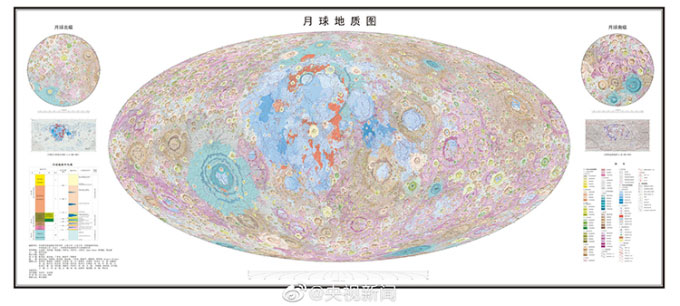China publishes the most detailed map of the Moon
China has released a new topographic map of the Moon with the most detailed 1:2,500,000 scale to date, revealing a variety of rocks and impact craters.
Scientists from the Institute of Geochemistry of the Chinese Academy of Sciences (CAS) and many other institutions such as the Chinese Academy of Geosciences, China University of Earth Sciences, Shandong University, established High-resolution lunar topographic map based on data from the Chang'e lunar exploration project as well as other data and research results from many international organizations. The new map was published in the journal Science Bulletin on May 30.

China published a topographic map of the Moon at a scale of 1:2,500,000. (Photo: Institute of Geochemistry of the Chinese Academy of Sciences (CAS)).
According to Chinese researchers, this is the most detailed map of the Moon ever, with a scale of 1:2,500,000, surpassing the surface map of the Moon produced by the Center for Space Geosciences of the National Institute of Geosciences. released by the United States Geological Survey (USGS) in 2020. This map, at a scale of 1:5,000,000, was prepared by the Center for Space Geosciences in partnership with NASA and the Planetary and Lunar Institute.
The new map includes 12,341 impact craters, 81 basins, 17 rocks and 14 types of structures, providing rich information about the geology and evolution of the Moon. It is expected to make a great contribution to scientific research, exploration and selection of a landing site on the Moon.
Over the years, China has successfully carried out many missions to explore the Moon. In January 2019, the Chang'e 4 spacecraft landed on the far side of the Moon, becoming the first vehicle to land in this area not visible from Earth. In December 2020, the Chang'e 5 spacecraft returned to Earth, bringing with it valuable samples of soil and rocks that it had obtained from the surface of the Moon.
China has also left its mark on the Moon. At least eight structures near where the Chang'e 5 landed are named after Chinese scientists and landmarks in May 2021. The International Astronomical Union (IAU), a Paris-based organization, has approved eight Chinese names for structures in the area near the Chang'e 5 landing site. The total number of geographical features on the Moon currently named China is 35. In addition, the country also plans to send crews to the Moon around 2030.
- Detailed 3D map of the Moon's surface
- 10 most beautiful Moon maps over the ages
- China exposes its ambition of US $ 10,000 billion in space
- China plans to send people to the Moon
- China experimented with technology to collect soil samples from the Moon
- China plans to explore the Moon
- China will bring secret technology to the Moon
- China responded to the ship Hang Nga to the Dark Moon in 2018
- China launched ships collecting specimens from the moon in 2017
- China announced plans to land on the moon in 2013
- China successfully tested the Module for the future Moon Station
- China has started producing Hang Nga 3 ships
 Van Allen's belt and evidence that the Apollo 11 mission to the Moon was myth
Van Allen's belt and evidence that the Apollo 11 mission to the Moon was myth The levels of civilization in the universe (Kardashev scale)
The levels of civilization in the universe (Kardashev scale) Today Mars, the sun and the Earth are aligned
Today Mars, the sun and the Earth are aligned The Amazon owner announced a secret plan to build a space base for thousands of people
The Amazon owner announced a secret plan to build a space base for thousands of people